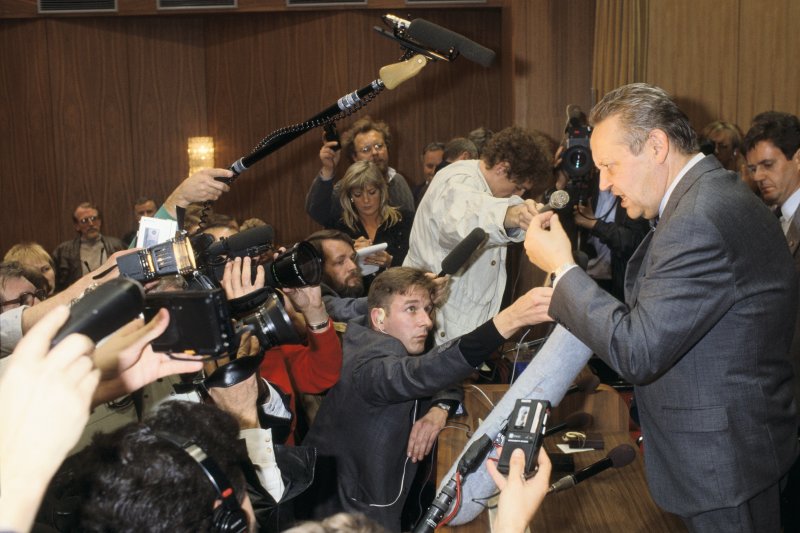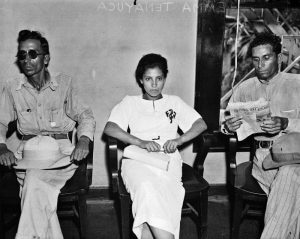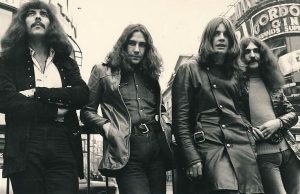The evening of November 9, 1989 quickly became a historical one as Günter Schabowski, an official of the Socialist Unity Party of East Germany, announced in a press conference that the inhabitants of East Germany could now travel to the West German side of the Berlin Wall after acquiring a simple travel visa. The announcement had a life-changing effect on the two German societies, West Germany and East Germany. There are also other factors that contributed and led to the fall of the Berlin Wall. But before we examine that remarkable night, let’s travel back to May of the same year, 1989.

The story really begins earlier that year, outside East Germany, at the border between Hungary and Austria. On May 2, the Hungarian government began to tear down the barbed wire fence that separated communist Hungary from the NATO-member country of Austria, which became an emotional gesture, as it allowed inhabitants of East Germany a route to West Germany that had been denied to them since 1949. East Germans often went on vacation to Hungary each summer, but in this particular summer of August 1989, as they traveled on vacation to Hungary, they kept going, through Hungary to Austria without any problems. And once in Austria, it was a simple matter of continuing on to West Germany. This event should be consider the first brick falling from the Berlin Wall.1
Then, on June 18, another major event took place outside of East Germany. Poland held elections for the Sejm, the lower house of the Polish Parliament, and for the Senate. For the first time in Poland’s history under the communist system, the non-communist political opposition group Solidarity was allowed to take part in the election process; the Polish Communist Party, in power for decades, felt the pain of a massive defeat. On that night, Solidarity won 92 of the 100 seats in the senate.2

These external events were noticed by East German citizens. East Germans themselves began to take action. Many strikes were held, one after the other, against the East Germany government. Revolts such as Neues Forum (New Forum), Demokratischer Aufbruch (Democratic Awakening), and Demokratie Jetzt (Democracy Now) incentivized East Germans to get prepared for an upcoming massive movement that started up in a church at Leipzig, East Germany.3
It all started in the summer of 1989, when East German citizens began attending Monday evening meetings at Leipzig’s Nikolaikirche, one of the major churches of central Leipzig, where they prayed and talked about politics. At the beginning, the movement was confused and politically naïve. But as the meetings grew larger and larger throughout the summer and into the fall, the sessions eventually turned into a major movement in the center of Leipzig. It turned into a wave of massive demonstrations that spread out through East German cities and helped Leipzig gain political strength and power for the upcoming main event. The meetings reached a high point on October 9, which has subsequently become a special day in German history. People flooded the streets of Leipzig with banners and chanted “Wir sind das Volk,” or We are the People.4
The strikes, combined with the events in Leipzig, finally led to the resignation of Erich Honecker, leader of GDR Germany, on October 18, 1989. He was replaced by Egon Krenz, who would be the last Communist leader of East Germany. The resignation of Erich Honecker motivated a yearning of the East German community to search for some new, desired future.5
By November, the huge demonstrations of Leipzig had spread to many other cities in East Germany, particularly to East Berlin. On November 4, East Germans escalated their protest throughout the country, demanding free elections, like Poland had just done. The crowd’s banners explained the needs of society with messages such as “40 years are enough” and “No lies–new people.”6 Up to this point, the idea of the wall falling was unimaginable; East Germans simply wanted to reform their government. They particularly wanted the ease and freedom to travel to West Germany without having to make the circuitous route through Hungary and Austria.
Then, on November 9, 1989, a press conference broadcast on live television in East Berlin changed the lives of East Germans forever. At 6:50 p.m., Günther Schabowski, spokesman for the East Berlin Communist Party, announced revised travel rules, which allowed East German inhabitants to leave the country with the use of a Visa.7 A journalist followed up Schabowski’s answer with the question, “When does it take effect?” Schabowski looked up and asked with confusion, “What?” Concerned and bewildered, the audience started to ask questions among themselves, which caused an uproar. After receiving such an important announcement, the crowd became worried that the travel rules would not be implemented in a timely manner, that this was just another government trick or delaying tactic. Günther Schabowski scratched his head, relocated his glasses, and casually replied in German, “Ab sofort.” In other words, immediately. No two words could have been more electrifying to those who heard them. Their implications were unfathomable, as East Berliners by the thousands began to process those words.8
Many East Berliners (and the world) at the beginning could not believe what they had just heard. News outlets and television stations began sending the breaking news that people could now freely pass through to West Germany by the border crossings in East Berlin. They no longer had to go “on vacation” to Hungary, through Austria, to get to West Germany. They could just go through the checkpoints between East Berlin and West Berlin.9 Even though the announcement was not supposed to initiate new traveling rules until the next day, Schabowski had been unaware of this. This supposed press conference became the trigger for a huge crowd to move towards those checkpoints at the wall. Thus, the phrase “Ab Sofort” was the unexpected catalyst of the East Germans’ liberation. As East Berliners moved towards the wall, they could see guards allowing the crowd into West Berlin. By 11:30 p.m., the wall was overflowing with people from both sides.10
As East Germans passed through the wall, they walked down the memorable street Kurfurstendam, or as West Berliners called it Ku’damm. As they walked down this street, lined with luxury stores of all kinds, they were simply amazed by the beauty and opulence of West Berlin. And, these East Germans could not believe that they were finally reuniting with their countrymen and kin. Kurfurstendam became a memorable place as East and West Germans walked down this stunning street together. The tears and joy could easily be seen through both the East and West Germans’ faces on that night. The scene then moved to the Berlin Wall itself, where East Berliners and West Berliners began climbing that symbolic wall of oppression. They danced on that wall that night, East and West. And they began taking hammers to that wall. That night began the end of the Berlin Wall. The chants of the East Germans’ “Wir sind das Volk” became “Wir sind ein Volk” for the first time that night.11

The events leading up to the fall of the wall were caused by both deliberate and unwitting actions. East German citizens had deliberately and determinedly protested their communist leadership, leading to the day when Schabowski accidentally guaranteed the overnight destruction of the wall. That night, Germans began a massive celebration with euphoric and victorious feelings. The news spread quickly to countries all over the world; these nations could not believe the wall was coming down either, and they held celebrations, which continued well beyond the sunrise of November 10. The joy the German people shared after such a long period of time, since 1961, continued throughout the night; the atmosphere was indescribable. Subsequently, the simple phrase “Ab Sofort” became an unforgettable and everlasting part of German history.
- Walter Mayr, “Hungary’s Peaceful Revolution: Cutting the Fence and Changing History,” Spiegel Online, May 29, 2009, http://www.spiegel.de ↵
- Steve Crawshaw, “Fall of the Berlin Wall: A people’s uprising that grew until it remade Europe,” Independent, October 28, 2014, http://www.independent.co.uk/us. ↵
- Alan Woods, “The Fall of the Berlin Wall,” Marxism, November 9, 2009, https://www.marxist.com ↵
- Andrew Curry, “We Are the People: A Peaceful Revolution in Leipzig,” Spiegel Online, October 9, 2009, http://www.spiegel.de/ ↵
- “Chronicle of the Berlin Wall,” Chronik Der Mauer, http://www.chronik-der-mauer.de/en/. ↵
- Derek Scally, “How the Berlin Wall Fell: A Chronology,” The Irish Times, November 7, 2014, https://www.irishtimes.com/. ↵
- Günther Schabowski, “Announcement That DDR Border Will Open,” September 21, 2011, https://www.youtube.com/watch?v=b8GzptqhT68. ↵
- Michael Meyer, “Günter Schabowski, the Man Who Opened the Wall,” New York Times, November 6, 2015, https://www.nytimes.com ↵
- BBC News, “The Fall of the Berlin Wall,” January 22, 2011, https://www.youtube.com/watch?v=fjNz1lvXgzU ↵
- Derek Scally, “How the Berlin Wall Fell: A Chronoogy,” The Irish Times, November 7, 2014, https://www.irishtimes.com/. ↵
- “We are the people” became “We are one people.” ↵



49 comments
Adelina Wueste
This article described the lead up to the fall of the berlin wall in a concise but detailed manner. Aside from the text, I really like how you included videos. The videos add even more information to your description of the events. I think its super interesting how people from East Germany would have to go through different countries just to make their way around to West Germany. I can’t imagine what it must have felt like for people in East Germany to see what West Germany looked like after being used to only seeing East Germany for so long. Overall, this article was very interesting and told the story of the fall of the berlin wall super well.
Sofia Perez
Hi Eduardo, I really connected with your article because when I was in middle school, I did a history poster of the Berlin Wall. Many people. who lived in East Germany tried to escape to West Germany. By the end of 1989, the Berlin Wall fell to unite Germany as a whole once more. I find it very interesting how the famous phrase, Ab Sofort, provided liberation to Germany.
Olivia Gray
I really enjoyed reading this article. You did a great job expressing how people in Germany felt during this time.The images you chose really helped tell your story, and the video clip is a great touch to the article. This article really helped me to understand the fall of the Berlin Wall.The peoples joy to be able to have their whole country back is amazing and shows how a nation is complete as a whole.
Vincent Villanueva
A great article on one of the biggest events in history, the fall of the great Britain wall. Such an insightful piece especially for the parts I was not aware of leading up to the fall. The meaning of Ab Sofort was not to my knowledge, but I do understand it very well and its relation to East Germany. I also want to point out the fact that East and West Germany and the rivalry between them is something that, in my opinion, does not get enough recognition that it should.
Andrea Tapia
I had remember hearing about the Berlin Wall in History classes that I took when I was young. It was nice to refresh my memory and hear about what happened and how it all went down. Amazing article, the fact that Berlin got separated into two sides I know it was difficult for a lot of families. If families would want to reunite with one another they would have to travel more to get to the other side. I am glad the wall started to come down and what events were going around that time. The images showed here were incredible and even with no words it said a lot to me. I learned a lot more reading it since its been a while since I had heard about it. They all deserved justice and to unite as a whole.
Sofia Perez
I think that the fact people had to short-cut going to West Germany by going through various countries. I also think it was very interesting that even though the country was divided by a wall, they found a common ground and came together to break the wall with hammers. The wall was a symbol of oppression, and I think this moment can be thought of as a turning point in German history with going toward a better government system.
Nicholas Quintero
This article is great! I enjoyed learning more about the social environment during this time period and how the people felt. the author does a great job of portraying the emotions the people of germany felt during this time and kept me engaged and interested throughout the article. I enjoy informative but very interesting topics like these that are well written!
Ki' Asya Jackson
I like that you mentioned the events leading up to the Berlin Wall falling. I also like that you explained what “AB Sofort” meant to these people and the joy it brought them. It is upsetting that Germans were separated but it was an exciting moment for them to be able to rejoice with one another. The images and details tell a story that results in a happy ending.
Daniel Gimena
I really enjoyed reading this article because it taught me a lot about the history of my country. I know that this moment meant a lot for the German people, and further analyzing this historical moment through this article has helped to further understand what it meant for both, the past and future, of Germany, Europe, the US and the Soviet Union.
Madeline Chandler
This was an extremely well-written article, and it was so detailed. I love the detail in this article. It was so interesting because I do not have much knowledge on the fall of the Berlin Wall This article really is thought-provoking because we see how the same people were separated and brought back together with such joy. We do not think of Easter vs. Western Germany, yet there were two Germanies not that long ago.